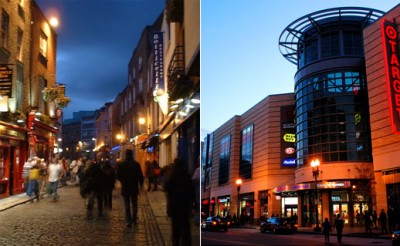The difference between a natural cultural district and a corporate cultural district

On the one hand you have authentic cultural destinations grown naturally, referred to as natural cultural districts (NCD)(image on the left), which attract creatives. On the other hand, you have developments that attempt to become such cultural destinations in one fell swoop, referred to on this site as corporate cultural districts (CCD)(image on the right). However, they tend to attract tourists and corporate employees with higher salaries than creatives. Here are the objective differences why, from a placemaking point of view:
Time: NCDs are built slowly over time, decades. CCDs are built completely within a couple of years.
Developers: NCDs involved multiple developers. CCDs involve just a few, and often only one.
Building age: NCDs have a mix of old and new buildings. CCDs are predominantly new buildings.
Building proportion: NCD buildings are often taller than they are wide, and not more than four to six stories. CCDs are almost always wider than they are tall, unless they exceed ten stories, which is often the case.
Building size: NCD buildings square footages are measure out to four (ie 5000 s.f.) or five digits (ie 50,000 s.f). CCD buildings are usually no less than six digits in square feet (ie 500,000 s.f.), even seven (ie a million s.f.), typically encompassing entire blocks.
Retail: NCD restaurants and shops are primarily local independents. CCD businesses are mostly chains.
Retail scale: NCDs almost never have big box stores. CCDs often have big box stores.
Entrepreneurs: NCDS often host entrepreneur-oriented workplaces. CCDs favor Class A corporate office space.
Images by Nik81 and M.V. Jantzen.
